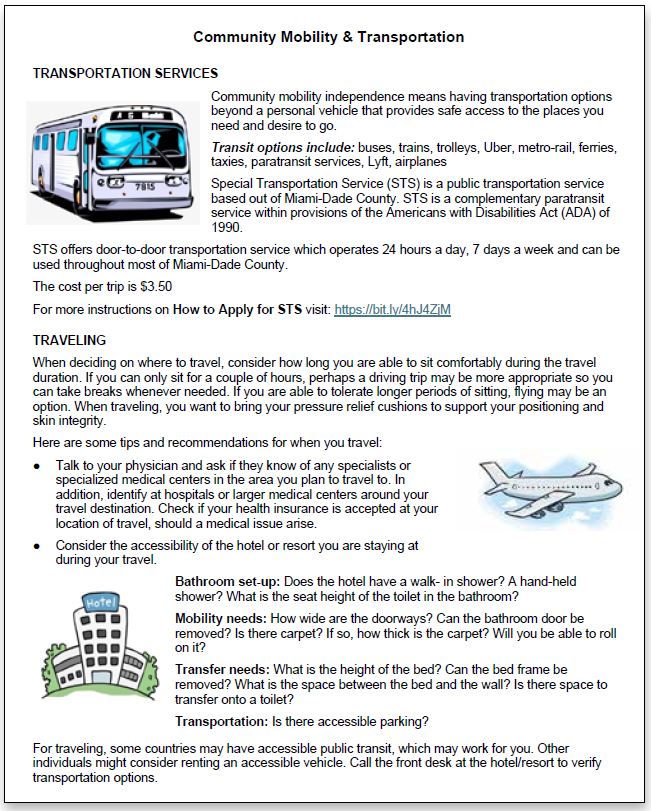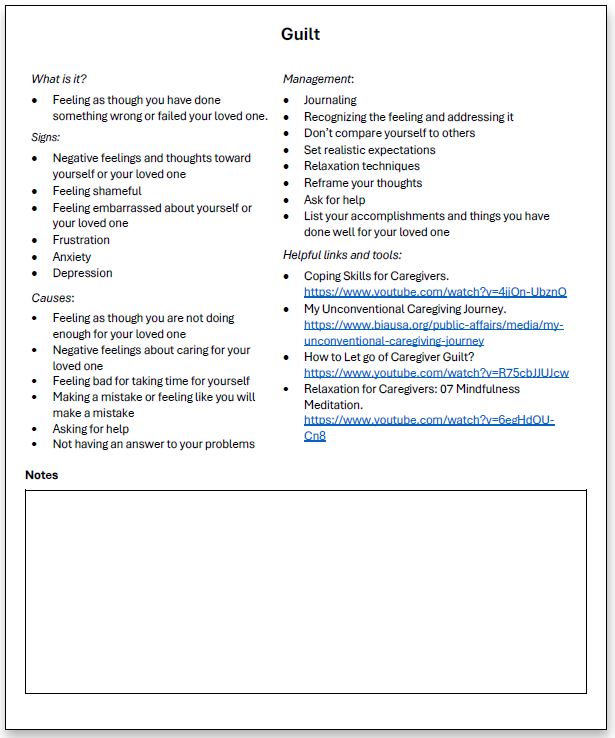Client education development and implementation
During the past 4 decades, hospital stays have declined for individuals who encounter neurological injuries. With decreased time available for skilled therapeutic services, occupational therapy practitioners (OTPs) are challenged to educate and instruct clients about discharge readiness while simultaneously increasing functional outcomes. Preparation for discharge or transition from rehabilitation services should be intentional and aim to be a road map to success from rehabilitation to clients’ expected community context. According to Guihan and colleagues (2022), OTPs play a vital role in helping individual clients and populations with spinal cord injury (SCI) and traumatic (TBI), including their loved ones and caregivers, in their transition planning. Typically, an individual’s discharge goal is to transition from rehabilitation services to their intended home or community environment with new skills and abilities to remain occupationally engaged while also managing new medical considerations (Guihan et al., 2022).
OTPs address occupation engagement and function as they relate to self-care and mobility, home environment, psychosocial factors, transportation, and caregiver support before discharge. They also communicate with the rehabilitation team members (Guihan et al., 2022). Furthermore, OTPs provide recommendations for durable medical equipment (DME), adaptive equipment, home environment modifications, and referral for continued rehabilitation services during the discharge planning process. One key intervention OTPs use to facilitate timely and effective discharge and transition planning is client and caregiver education. Clients who receive pointed education on discharge planning report fewer declines in occupational performance, enhanced mastery in a specific skill, improved self-efficacy and well-being, and require less help from caregivers, according to the Occupational Therapy Practice Framework: Domain and Process (OTPF-4; American Occupational Therapy Association [AOTA], 2020).
Education as a Key Intervention
Education focuses on providing knowledge and information to clients, groups, and populations regarding occupation, health, and participation (AOTA, 2020). OTPs should ensure that education is client centered, delivered early in the plan of care, and provided to both clients and their caregivers. Within a therapy session, the opportunity for clients to teach back the education provided is essential for carryover in their home environment. Allowing for teach back provides an opportunity for clients and caregivers to identify occupational risks, clarify recommendations, and confirm the established plan for anticipated occupational needs in the home and community. With strategic education on community resources, the transition to home and community may improve client and caregiver confidence and readiness for a successful transition to the preferred home setting (see Figure 1).
Figure 1. Education Focus for Discharge and Transition Planning
- Environmental modification recommendations
- Adaptive equipment and durable medical equipment (DME) recommendations
- Occupation adaptation skills
- Caregiver training
- Community and referral resources
Education can support the development of new habits, routines, or skills that support a safe, effective, and meaningful participation in occupations for individuals with neurological conditions. When planning for transition from skilled occupational therapy services, OTPs need to ensure the education is vetted using accurate and relevant evidence specific to the client’s condition and functional needs. OTPs have the knowledge and skills to create client education handouts and resource materials that are relevant, evidence-based, accessible, and tailored to individual occupational needs for those with newly diagnosed neurological conditions.
Within two inpatient rehabilitation facilities, occupational therapists (first and second authors, Ashley and Montana) noted a gap in education related to discharge planning for clients and their families transitioning home with a new SCI or TBI diagnosis. After completing a needs assessment with facility rehabilitation management and team members, we determined that more evidence-based, function-focused education handouts could be used strategically by OTPs in a 3-week period to prepare clients and their families or caregivers for the transition to their occupational performance at home and in the community. Specifically, handouts would provide client education on self-care management (e.g., bowel and bladder management, adaptive equipment use for dressing), functional mobility with transfer equipment, transportation and community resources, and caregiver support and coping skills. We used an evidence-based approach to create relevant and accessible handouts that would support OTPs’ educational intervention approach.
Education Accessibility and Context
Education and advocacy are both important intervention areas implemented by OTPs. As described in the OTPF-4, OTPs provide client-centered care and have the unique role of creating educational resources that reflect the client’s needs. OTPs can use Universal Design for Learning (UDL) guidelines to create educational handouts for clients and caregivers that are individualized, relevant, and accessible for a variety of learning preferences and communication modes. UDL consists of three key principles: (1) multiple means of engagement, (2) multiple means of representation, and (3) multiple means of action and expression (CAST, 2025).
By incorporating these principles (see Figure 2 for definitions), OTPs consider what engages the client or caregivers, cultural differences and language considerations, and differences in application and expression of learned skills. Furthermore, OTPs need to look at the design and formatting for each educational handout to ensure they support the learning preferences of the target audience(s). For example, handouts need to use appropriate font size and style, contrast and white space, and relevant images. OTPs can deliver education through other modes, too, such as having the handouts read through automatic reading devices, personal device applications, or narrated videos.
To establish readability and understandability of client and caregiver education materials, it is beneficial to use a readability assessment tool. Several such tools are available to ensure reading accessibility and comprehension, including the widely used Simple Measure of Gobbledygook (SMOG; Yurdakul et al., 2021). The average American reads at an eighth grade reading level, and one in five Americans reads at a fifth grade level (Grabeel et al., 2018). Client education handouts should be created to target the reading level as well as cultural aspects of the intended population receiving the information, which promotes knowledge translation as well as carryover of intended skills or knowledge being shared. After education content is developed, OTPs can put the written content through the SMOG tool, which uses a reliable formula to calculate the reading level required to understand the handout (Grabeel et al., 2018) It is also important for OTPs to consider the accessibility features (e.g., background to font color contrast, font size, header use) when delivering education electronically (Grabeel et al., 2018). These accessibility features need to be used with paper or electronic formats (e.g., websites, application programs) to ensure reading devices (e.g., screen readers, magnification systems) are able to capture all written words accurately on the document or page (CAST, 2025).
Figure 2. Universal Design for Learning: Principles and Definitions
- Engagement: Centering, affirming, and sustaining learners’ interests and identities
- Representation: Authentically representing diverse identities, perspectives, and narratives
- Action and expression: Honoring and valuing a variety of forms of communication
Note. Adapted from CAST (2025)
Handout 1: Preparing for Life After Spinal Cord Injury
To address the aforementioned gap in education related to discharge planning, we created two client education handouts. The first handout on community mobility and transportation highlighted local and national transportation systems (see Figure 3). The handout includes URLs—selected based on UDL principles—for visual demonstrations, uses Arial, size 12 font, has no underlined text, and has high contrast between the font color and the background. Images are simple and non-distracting to promote skilled techniques. The occupational therapist put the text through the reading accessibility tool, SMOG, and the score was 8.2 (eighth grade reading level). The handout was used in intervention sessions during an average 3-week inpatient rehabilitation unit length of stay.
Figure 3. Community Mobility and Transportation Handout

Handout 2: Psychosocial Considerations for Caregivers
We developed a second handout to facilitate caregiver emotional support. This handout includes resources on caring for oneself, and it is shared with all individuals who may be caring for someone with a new TBI diagnosis (see Figure 4). This handout also includes URLs—selected based on UDL principles—for visual demonstrations, and uses PT Serif, size 16 font, has no underlined text, and has high contrast between the font color and background. Using these accessibility features support magnification or screen reading devices or personal phone applications that may read the paper handouts. A notes section in this handout allows clients or caregivers to add their own information. The OT put the text through the reading accessibility tool, SMOG, and the score was 4.76 (fifth grade reading level). OTPs within the rehabilitation unit reviewed the handouts to ensure feasibility and timing of use in practice.
These two handouts are used in intervention sessions at least 48 hours before a client is discharged and as early as the first intervention session to assist clients and their caregivers with supportive services and resources as they transition home.
Figure 4. Caregiver Support Handout

Practitioners’ Crucial Role in Access to Resources
Providing education about health or occupational needs beyond post-acute care rehabilitation settings as well as sharing related community resources are important for a successful transition to the client’s anticipated home environment and support system. Education is a skilled intervention that can aid the knowledge of clients and their caregivers in optimizing participation and engagement in daily occupations. By using UDL principles and reading accessibility tools, OTPs can increase the accessibility of their educational tools. OTPs have a role in the development of client education handouts to ensure knowledge resources are accessible, inclusive, and client centered.
References
American Occupational Therapy Association. (2020). Occupational therapy practice framework: Domain and process (4th ed.). American Journal of Occupational Therapy, 74(Suppl. 2), 7412410010. https://doi.org/10.5014/ajot.2020.74S2001
CAST. (2025). The UDL guidelines. http://udlguidelines.cast.org
Grabeel, K. L., Russomanno, J., Oelschlegel, S., Tester, E., & Heidel, R. E. (2018). Computerized versus hand-scored health literacy tools: A comparison of Simple Measure of Gobbledygook (SMOG) and Flesch-Kincaid in printed patient education materials. Journal of the Medical Library Association, 106, 38–45. https://doi.org/10.5195/jmla.2018.262
Guihan, M., Roddick, K., Cervinka, T., Ray, C., Sutton, C., Carbone, L., & Weaver, F. M. (2022). Physical and occupational therapist rehabilitation of lower extremity fractures in veterans with spinal cord injuries and disorders. Journal of Spinal Cord Medicine, 45, 33–41. https://doi.org/10.1080/10790268.2021.1890680
Yurdakul, O. V., Kilicoglu, M. S., & Bagcier, F. (2021). Evaluating the reliability and readability of online information on osteoporosis. Archives of Endocrinology and Metabolism, 65, 85–92. https://doi.org/10.20945/2359-3997000000311
Ashley Castillo, OTD, OTR/L, CSRS, is an Occupational Therapist at both West Gables Rehabilitation Hospital at Select Medical and Rehab Without Walls-Miami. She is also a Lab Instructor at University of St. Augustine for Health Sciences at the Miami campus.
Montana Nunez, OTD, OTR/L, CBIS, is an Occupational Therapist at Encompass Health Rehabilitation Hospital and an Associate Professor at Faulkner University. She practices in inpatient rehabilitation and works with the neurological population.
Hannah Oldenburg, EdD, OTR/L, BCPR, is an Associate Program Director and Associate Professor at the University of Minnesota in Rochester, MN. She also practices acute care at Mayo Clinic-Rochester for populations with general medicine, cardiovascular, or orthopedic conditions.